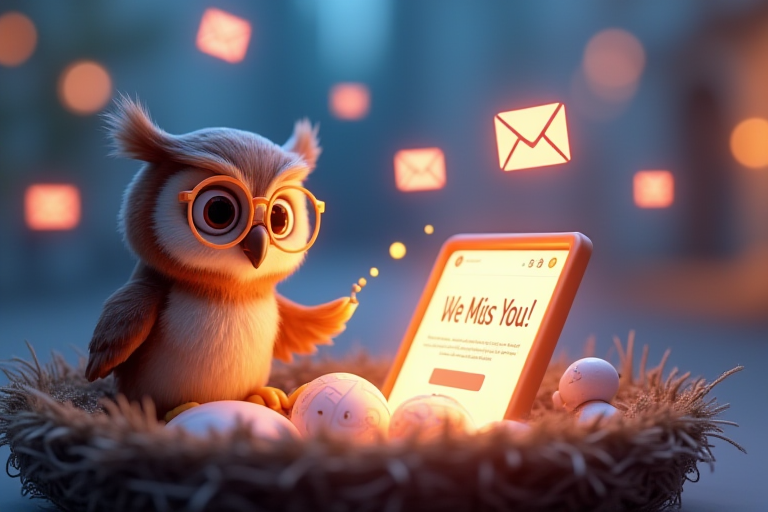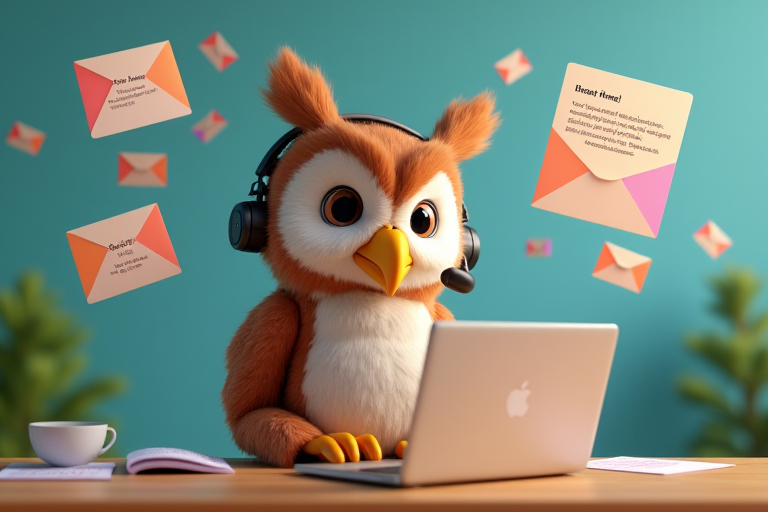Trends and the future of email marketing: what works in 2025

- Personalization on a new level
- AI and automated scripts
- Email chain automation
- Optimization of sending time
- Content generation
- Defining “dormant” subscribers
- Interactive letters
- Product carousels
- Built-in forms and surveys
- Mini-games and gamification
- Dynamic content
- Privacy rules and new laws
- How have privacy laws changed in 2025?
- What is now prohibited?
- How to meet new requirements?
- How will these changes affect email marketing?
- How to prepare your strategy for the future
1. Personalization on a new level
Email marketing in 2025 will become even more personalized. It’s no longer enough to simply insert the subscriber’s name in the subject line or the first sentence of the email. Users expect deeper personalization that takes into account their behavior, preferences, and even psychological triggers.
Personalization used to be simple:
- “Hello, Alexey!”
- “We know you like smartphones”
- “Your favorite product category is now on sale!”
Today, that’s not enough. People get too many emails, and to really engage a subscriber, you need more.
Hyperpersonalization: what is it?
This is a new level of personalization that uses real-time user data . Emails are now not just “tailored” to a specific subscriber, but created uniquely for them .
How does it work?
📌 Real-time data – instead of static templates, email content changes depending on user behavior on the site or in the app.
📌 Dynamic content – instead of sending the same email to everyone, each user receives an email with unique offers relevant to them.
📌 Artificial intelligence-based content – AI can predict which products will be interesting to a user based on their purchase history and interests.
📌 Predictive personalization – email marketing no longer relies on the subscriber’s past actions, but predicts what they will want to do in the future.
Example of a personalized email in 2025:
Imagine you went to a website and looked at shoes, but didn’t buy anything. Instead of the usual email with a reminder about the product, you get:
“Hi, Alexey! 👋We noticed that you were considering the new Nike Air Max model. Amazing choice!By the way, similar models are currently trending among our customers.We also have a special -10% discount just for you, valid until midnight!Don’t delay – click here to complete your purchase 🛍️”
What’s changed here?
✅ Not just a name, but a specific product that the user viewed was used
✅ Added social proof (“similar models are trending”)
✅ Used an urgent offer that stimulates action
✅ The letter does not look like a standard reminder, but like a personal appeal
What does a business need to do?
🔹 Collect more qualitative data about users (purchase history, behavior on the site, interests)
🔹 Use dynamic email templates that adapt in real time
🔹 Implement AI analytics to predict subscribers’ desires
🔹 Test different levels of personalization and find the perfect balance
Personalization is no longer a trend – in 2025 it is a must-have for survival in email marketing.
2. AI and automated scripts
Artificial intelligence (AI) is no longer a fantasy, but a reality in modern email marketing. In 2025, its role is only growing: companies no longer spend hours on manual segmentation, analysis of discoveries and choosing the ideal time to send emails. All this is done by AI, creating individual communication scenarios for each subscriber.
How is AI changing email marketing?
1. Automation of email chains
Previously, automatic chains looked quite simple:
- Letter #1 – greeting after subscription
- Letter #2 – reminder in a few days
- Letter #3 – offer to buy a product
Now AI makes them flexible and intelligent . For example, if a subscriber did not open the first email, the system can automatically change the subject and resend it at the optimal time. If a person opened the email but did not click on the link, AI will determine what interested them and suggest another interaction.
Example:If a user opened an email with a discount but didn’t purchase the product, AI can send them a reminder with social proof (“95% of our customers rated this product 5 stars”) or add a personalized offer.
2. Optimization of sending time
AI learns from subscriber behavior and determines when each user typically reads emails. For example, one person opens an email during their morning coffee, while another opens it after work. In 2025, email marketers will no longer send “10:00 AM to everyone” emails – AI will do it personally.
3. Content generation
AI can not only change headlines, but also create personalized texts for each user. For example, it can adapt the tone of voice of the letter:
- For a youth audience – add emojis and informal addresses
- For the business segment – make the text more official
- For regular customers – add personal offers
Example:If a subscriber often buys technology, AI can independently create an email:
“Hi, Alexey! We know you are interested in gadgets, and here is a new product that will interest you – a smartphone with the best camera of 2025! See the review here.”
4. Визначення “сплячих” підписників
AI аналізує активність підписників і визначає, коли людина починає втрачати інтерес. Наприклад, якщо користувач не відкривав листи протягом 3 місяців, AI може запропонувати спеціальну реактиваційну кампанію або запропонувати йому інші канали зв’язку.
Що потрібно робити бізнесу?
✅ Використовувати сервіси email-маркетингу з AI-аналітикою (наприклад, Mailchimp, HubSpot, ActiveCampaign)
✅ Запускати розумні автоматизовані кампанії, які адаптуються до поведінки підписників
✅ Використовувати AI для тестування тем, контенту та персональних рекомендацій
✅ Дозволити AI самостійно змінювати розсилку в режимі реального часу
Штучний інтелект робить email-маркетинг не просто зручнішим, а значно ефективнішим.
3. Інтерактивні листи
Електронні листи давно перестали бути просто текстом із кнопкою “Купити”. У 2025 році трендом стали інтерактивні email, які дозволяють взаємодіяти з контентом прямо у листі. Це не тільки підвищує залученість, а й значно скорочує шлях користувача до цільової дії.
Що таке інтерактивний email?
Це лист, у якому користувач може натискати на кнопки, переглядати каруселі товарів, проходити опитування, грати у міні-ігри чи навіть оформлювати покупку — без переходу на сайт.
Якщо раніше інтерактивність була обмежена лише GIF-анімаціями та простими кнопками, то зараз все значно цікавіше.
Які інтерактивні елементи працюють у 2025 році?
1. Каруселі товарів
Уявіть: користувач відкриває email і одразу бачить прокрутку товарів, які може гортати так само, як у мобільному додатку. Це зручно, бо дозволяє знайти потрібний продукт без переходу на сайт.
Приклад:
Магазин техніки у розсилці пропонує останні смартфони. Користувач може гортати їх, дивитися характеристики та додати в кошик прямо у листі.
2. Вбудовані форми та опитування
Замість того, щоб просити людину перейти на сайт і заповнити форму, її можна вбудувати прямо у лист. Це значно підвищує конверсію.
Приклад:
Компанія проводить опитування: “Який із продуктів вам цікавий?”. Користувач обирає варіант відповіді прямо у листі, і на основі цього йому приходять персональні пропозиції.
3. Міні-ігри та гейміфікація
Гейміфікація давно стала трендом у маркетингу, і тепер вона потрапила в email. Розіграш з обертанням колеса фортуни, міні-квести або лотереї роблять розсилку цікавою та залучають підписників.
Приклад:
“Крутніть колесо та дізнайтеся свій бонус!” Користувач натискає на колесо, воно обертається прямо у листі, і система видає йому знижку.
4. Динамічний контент
Листи тепер можуть змінювати свій вміст в реальному часі. Наприклад, якщо ви відкриєте email зараз, а потім ще раз через три години — він може показати іншу пропозицію.
Example:
An airline sends out an email with ticket prices. If seats run out, the email automatically updates to show new options.
How to create an interactive letter?
For interactivity to work, you need AMP for Email , a technology supported by Gmail, Yahoo! Mail, and some other email services. It allows you to embed interactive elements that work without going to the site.
✅ Use AMP to create interactive emails
✅ Test whether interactive content works in your subscribers’ email services
✅ Use interactive elements only where they truly improve the experience
Should you introduce interactivity into your emails?
Yes, if your audience uses email services that support AMP and it’s important for you to engage users through interesting content.
However, it is important to remember that some email clients (e.g. Outlook) may not support interactive elements, so it is always a good idea to have an alternative version of the email without AMP.
4. Privacy rules and new laws
Every year, companies are increasingly restricted in their ability to collect and use personal data. In 2025, email marketers will have to play by even stricter rules. If you don’t want to get fined or lose customer trust, you need to understand the basic requirements for data processing.
How have privacy laws changed in 2025?
A few years ago, the main regulations were GDPR (Europe) and CCPA (California, USA) . However, now the regulation has become stricter:
✅ DMA (Digital Markets Act, EU) – restricts data use by large platforms
✅ ADPPA (American Data Privacy Protection Act, USA) – federal privacy law
✅ Digital Content Act (UK) – strengthens control over mailings
✅ ePrivacy Regulation (EU) – expands consent rules for email marketing
What does this mean for marketers?
It used to be enough to simply get a customer’s email and sign them up for a newsletter. Now you need to explain how their data will be used and provide an easy way to unsubscribe.
Example:
If a person subscribes to your newsletter but doesn’t open your emails after a year, you must either obtain new consent from them or delete their data.
What is now prohibited?
In 2025, the following methods of collecting and using email have become illegal or risky:
🚫 Automatic subscription without consent
It is forbidden to add a person to the mailing list simply because they made a purchase or registered on the site.
🚫 Open access lists
It is prohibited to buy, sell, or take email addresses from public databases.
🚫 Hidden checkboxes
The subscription form should clearly show that a person is subscribing to an email, without “default checkboxes”.
🚫 Data retention without consent renewal
If a person does not interact with emails, they should be asked if they want to remain in the database.
How to meet new requirements?
✅ Clearly explain what the person will receive.
The subscription should be accompanied by a clear explanation: “You will receive 2 emails per week with useful tips and discounts.”
✅ Add a simple unsubscribe button.
Violating the rules by not having an “Unsubscribe” button can cost you big fines.
✅ Keep confirmation of consent
It is important to have a record of when and how a person consented to receiving an email.
✅ Encrypt and protect databases.
If your database is leaked to the internet, you will be responsible for it.
How will these changes affect email marketing?
On the one hand, marketers will have to adapt their approaches to comply with the new laws. But on the other hand, it means that the audience will become more qualitative .
People who really want to receive your emails will engage more with your content, which will increase brand trust and email conversion rates .
5. How to future-proof your email strategy
The world of email marketing is changing rapidly. What worked in 2023 may not be effective in 2025. To avoid losing your audience and achieve consistent results, companies need to adapt to the new conditions.
How to prepare your strategy so that it remains relevant in the coming years?
Step 1. Focus on quality, not quantity
Many companies still try to send as many emails as possible, hoping that at least some of their audience will respond. But in 2025, personalized communication will work more effectively.
What should be changed:
✅ Segment your audience by interests, not just demographics
✅ Use behavioral triggers to send emails at the right time
✅ Reduce the frequency of emails to inactive subscribers
Example:
Instead of sending the same email to all subscribers, divide the base into groups: new subscribers, those who have just made a purchase, or those who have not interacted for a long time.
Step 2. Implement AI for automation
Artificial intelligence makes life much easier for email marketers. It allows you to analyze user behavior, recommend optimal content, and even generate unique email texts.
How AI can help you in the future:
✅ Predict which emails will be opened best
✅ Determine the best time to send
✅ Generate personalized topics and texts based on subscribers’ preferences
Example:
Instead of manually testing different email subjects, AI can automatically select those with the best open rates.
Step 3. Optimize your mailings for new privacy rules
User privacy will matter even more in 2025. New laws and changes to iOS and Gmail may limit traditional email marketing metrics such as email opens.
What you can do now:
✅ Emphasize the benefits of subscribing so that people stay in the database voluntarily
✅ Use UTM tags to analyze email conversions in Google Analytics
✅ Add more interactive elements to track engagement (e.g. polls or answer buttons)
Step 4. Invest in the visual component of your email
People are reading less and less long text emails, and are paying attention to design instead. Interactive, animated, and visually appealing emails are getting higher engagement.
What you should change in your newsletters:
✅ Use a responsive design that looks good on any device
✅ Add videos and GIFs
✅ Make emails look like website pages with interactive buttons
Example:
A company can send not just a text email about a new product, but an interactive email with a 3D product overview.
Step 5. Test and adapt
There is no single recipe for success in email marketing, so it is important to constantly test different strategies and adapt them to changes.
What to do regularly:
✅ A/B test themes, CTAs, and visuals
✅ Analyze metrics (not just opens, but also clicks, engagement time)
✅ Experiment with the frequency of newsletters
Conclusion
Email marketing will be even more personalized, interactive, and automated in 2025. Companies that adapt to new trends in a timely manner will be able to not only maintain the effectiveness of their mailings, but also significantly increase conversion.
What to do now:
✔ Update your strategy to take into account new technologies
✔ Invest in personalization and AI
✔ Comply with privacy laws
✔ Work on the design and interactivity of emails
✔ Constantly test and adapt email campaigns
If you implement these changes into your strategy, your email campaigns will not only be relevant, but also as effective as possible in the coming years. 🚀



